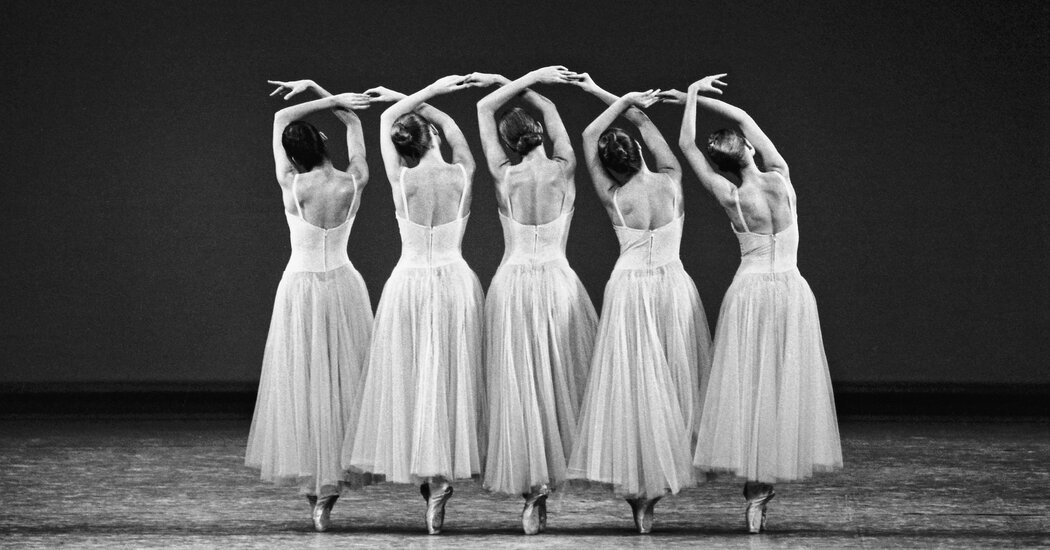Misty Copeland on ‘Serenade,’ Democracy and the Art of Movement
SERENADE
A Balanchine Story
By Toni Bentley
Toni Bentley’s sixth book, “Serenade,” is a tribute not only to the Georgian American choreographer George Balanchine’s timeless, titular ballet, but also to the art form. Bentley, who danced under Balanchine’s direction at the New York City Ballet for a decade in the 1970s and ’80s, tells a history that is as vivid and poetic as the dance itself.
“‘Serenade’ is, for me, a map of Balanchine’s soul,” she writes, and as the first ballet he premiered in America, in 1934, it has become a kind of initiation rite for all the dancers who have been fortunate enough to dance for him since. As Bentley puts it, “Every girl who has stood in one of those two aerial diamonds of the opening formation has stood where many have stood before her in apostolic succession.”
But “Serenade” the book is about more than the making of a single ballet; it is an introspective nod to the life lessons taught through movement, told from the perspective of a young ballerina whose underlying drive came down to “no romance, no tulle, no tiara, no spotlight, no dreams of stardom, just an unwavering surge to survive when I was told I might not.”
I have yet to dance “Serenade,” but I felt the spirit of the movements through Bentley’s descriptive prose. She weaves in impressive detail about the actual technique of ballet, articulating the dancer’s physical experience for the reader. Turnout, she writes — “the rotation of both legs from the hip sockets in opposite, outward directions, simultaneously” — is both the “core” and the “central contradiction” of classical ballet. But in the beginning of “Serenade,” Balanchine calls for the 17 dancers on the stage to turn their feet “parallel, like ordinary mortals.” Given their training, this position feels so awkward and off-balance that when, a minute and a half into the piece, they suddenly rotate their feet outward, the physical relief coincides with a profound sense of opening. “Turnout offers all directions, any direction, every direction,” Bentley writes. “When parallel splits open, the world splits too.”
Bentley traces the history of ballet from its origins in the court of King Louis XIV — who tried via royal decree to regulate dancers’ techniques and to “clean up the rampant practice of jumping about any old which way” — to contemporary works of today. And within this long arc she places Balanchine’s own evolution from Georgi Balanchivadze, a “son of Russian imperial heritage,” to an egalitarian visionary in the West. “Serenade,” she says, showcased his notion that the female dancer reigned supreme, as she had not before. In a close reading of a particular movement within this abstract ballet, Bentley makes a convincing case that through the push and pull between a solo dancer and the ensemble she longs to join, Balanchine “equalized” all his performers, “releasing soloists from their rigid pedestals and the corps de ballet from its decorative function, thus freeing both.” The ramifications for the form were significant: “Balanchine did not so much change an aspect of the art … as push it, in its lush entirety, onto entirely new ground.” Flipping classical tradition on its head, he brought democracy to ballet.
Reading Bentley’s “Serenade” made me feel as alive as I felt on the stage the moment that I fell in love with ballet: with its grounded fantasy, physical demands, intellectual challenge, structure and beauty. Like the author, I too was drawn in by the fight to be my best, to chase perfection, to prove myself.
Although Bentley’s relationship with Balanchine didn’t develop until the end of his life — she writes of sitting by his hospital bed before he died in 1983 — his influence remains with her today. Returning from a hip injury at 25, four months after he died, Bentley coaxed her joint to heal “centimeter by centimeter,” until “I danced better than I ever had, for now it was truly, finally, life or death for me. The ‘fuego,’ the ‘fire,’ Balanchine sometimes referred to in class was lit.”
“Serenade” is a book that will delight balletomanes for generations to come; but it will also appeal to those newer to the dance world, with its delicate balance of personal memoir, rarefied elegance, history of the arts and pure human interest.
Check out our Latest News and Follow us at Facebook
Original Source







